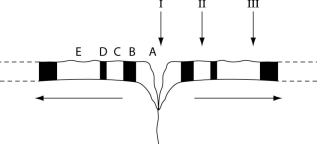Question 52
(Multiple Choice)
The following questions refer to the description and figure below.
The figure represents a cross section of the sea floor through a mid-ocean rift valley, with alternating patches of black and white indicating sea floor with reversed magnetic polarities. At the arrow labeled "I" (the rift valley), the igneous rock of the sea floor is so young that it can be accurately dated using carbon-14 dating. At the arrow labeled "III," however, the igneous rock is about 1 million years old, and potassium-40 dating is typically used to date such rocks. Note: The horizontal arrows indicate the direction of sea-floor spreading, away from the rift valley.

Figure 25.1
-Which section of sea-floor crust should have the thickest layer of overlying sediment, assuming a continuous rate of sediment deposition?
A) A
B) B
C) C
D) D
E) E
Answer